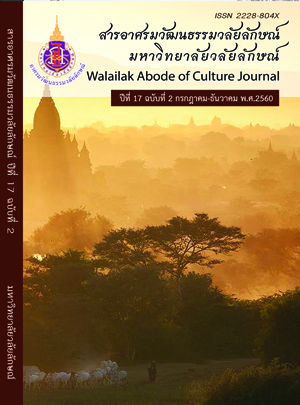บทบาทหญิงชายในการศึกษาระดับประถมของประเทศเมียนมา
Main Article Content
Abstract
การศึกษานี้มีวัตถุประสงค์เพื่อศึกษาบทบาทหญิงชายในการศึกษาระดับประถมของประเทศเมียนมา ตามหลักสูตรการศึกษาของกระทรวงศึกษาธิการ ประเทศเมียนมา ข้อค้นพบสำคัญของการศึกษานี้ คือ ทัศนคติเกี่ยวกับผู้ชายที่มีบุญบารมียังคงถูกให้ความสำคัญ ในฐานะของบุคคลที่มีบุญบารมีที่สูงส่ง มีความรู้ความสามารถ และอยู่ในระดับที่สูงกว่าผู้หญิง เนื้อหาในตำราเรียนอธิบายถึงหน้าที่หรือการแบ่งหน้าที่ของหญิงและชายไว้ออย่างชัดเจน แต่ในความเป็นจริงแล้วเนื้อหาในตำราเรียนเหล่านี้แสดงให้เห็นถึงความแตกต่างทางเพศ มีการนำเสนอเรื่องราวของเพศชายมากกว่าเพศหญิงเกือบทุกด้าน ประการแรก คือ ด้านครอบครัว ตำราเรียนนำเสนอภาพ “พ่อ” ในฐานะของเสาหลักของครอบครัว เปรียบเสมือนเทพประจำบ้าน ในขณะที่ “แม่” ซึ่งเป็นเพศหญิงนั้นเป็นเพียงผู้ดูแลและผู้สนับสนุนสมาชิกในครอบครัวเท่านั้น ประการที่สอง คือ ด้านการทำงาน อาชีพที่ได้รับการยกย่อง มีผู้นับหน้าถือตา และมีความมั่นคงของสังคม คือ ทหาร แพทย์ ครู ซึ่งเนื้อหาต่างๆ ที่เกี่ยวกับอาชีพส่วนใหญ่นั้นถูกอธิบายและถูกแทนด้วยภาพของเพศชาย อาชีพที่ได้รับเกียรติของเพศหญิง คือ อาชีพครู และพยาบาล ซึ่งมีหน้าที่ในการดูแลผู้อื่น อาชีพของเพศหญิง คือ อาชีพที่ต้องมีความมุ่งมั่น ตั้งใจ และเสียสละเพื่อดูแลผู้อื่น รวมทั้งผู้หญิงยังไม่ได้รับการนำเสนอในภาพของแม่บ้าน ผู้ที่ทำหน้าที่ในการดูแลบ้าน ครอบครัว และสมาชิกในบ้านได้อย่างมีประสิทธิภาพ และประการที่สาม คือ ด้านสังคม ผู้ชายพม่าถูกคาดหวังให้เข้ามามีส่วนร่วมในการดำเนินการต่างๆ ในสังคม เด็กๆ เริ่มจากการมีส่วนร่วมภายในโรงเรียน และขยับขยายออกสู่ระดับประเทศตามลำดับอายุที่มากขึ้น ในขณะที่ผู้หญิงนั้นถูกคาดหวังในเรื่องความงาม การมีหน้ามีตาในสังคม และการชี้ให้เห็นว่าผู้ชายมีโอกาสในการเรียนรู้สิ่งรอบข้างมากกว่าเพศหญิง และพื้นที่ของเพศหญิงถูกจำกัดไว้แค่พื้นที่ที่ปลอดภัยเท่านั้น
Gender Roles in Myanmar’s Elementary School
This research project investigates the roles of men and women that have been demonstrated in the textbooks of primary schools by the Ministry of Education of Myanmar. It finds that patriarchy is more emphasized. Men are believed as the charismatic leaders and educated, while women are viewed as inferiors. Having scrutinized the contents of those textbooks in detail, it also finds that careers are categorized according to their sexuality. In addition, the contents of those textbooks illustrate the differences of gender. The male roles are represented more than female. First, in terms of family, textbooks represent the figure of “father” as the family’s leader. He is also symbolized as a god in his house. In contrast, a “mother” is compared to a domestic worker who supports all family members. Second, for careers, the admirable and stable occupations are soldiers, doctors, and teachers, which most of those pictures are represented by men. For women, their recommended careers are teachers and nurses, which educate women to serve and take care of others. However, the pictures of housekeeper and family’s supporter of women have not been potentially represented. Third, in social aspect, Burmese men are expected to participate in every social activity. Boys have to play a vital role in their schools and their roles are of course extended when they are growing up. Meanwhile Burmese women are expected to gain social respect through their beauty. However, their opportunity in learning is less than men because their lives are limited within some spheres.
Article Details
© 2018 by Asian Journal of Arts and Culture, Walailak University. All rights reserved.


